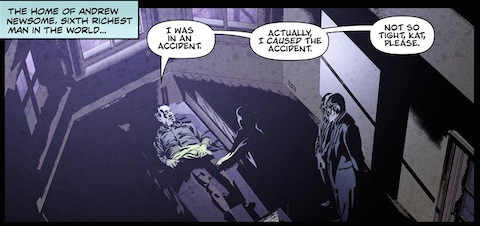Just as no list of the most 1990s-defining filmmakers could do without Quentin Tarantino, no list of the most 1990s-defining television shows could do without ER. The long-running, award-laden medical drama made more than a few daring moves over its fifteen years, not least its choices of guest directors. Early in its very first season (which premiered a month before the release of Pulp Fiction), ER snagged Tarantino to direct the episode “Motherhood,” which aired on May 11, 1995 — three days before Mother’s Day. “The ratings for ER, which are usually through the roof, should be through the moon tonight,” wrote the Baltimore Sun’s David Zurawik, “And there is enough Tarantino to warrant a bit of a buzz. One weird scene involving a fight between female gang members as they are being wheeled into the emergency room might even be considered inspired when judged against the usual standards of doctor drama. But be warned: It’s ultra-bloody.”
That quote comes from a roundup of contemporary write-ups of the episode at Chronological Snobbery, which gets into impressive detail on the story behind, the plot of, the hype surrounding, and the Tarantinian imagery in “Motherhood,” and it also offers a brief interview with former child actor Abraham Verduzco, who “played Palmer, one of the eight Ranger Scouts with diarrhea.” Tarantino fans of the type who would frequent the Quentin Tarantino Archive will have recognized Verduzco from his earlier appearance in Robert Rodriguez’s Tarantino-featuring Desperado. “The episode boasts the usual intertwined stories of bleeding gangsters, relationship trouble, family drama, pregnancies, drug abuse and forbidden love,” says the QTA. “What makes this episode so interesting to Tarantino fans are all the QT trademarks that one can spot through the episode.” Some of these, aside from a penchant for vintage shades (“Quentin picked out the sunglasses and was adamant we wear them,” said actress Julianna Marguiles), include:
- Dr. Lewis wears a Yosemite Sam t‑shirt
- Pulp Fiction’s Angela Jones appears as Michelle
- A Beatles song (“Blackbird”) accompanies a birth
- The Ranger Scouts act like the Three Stooges, and Dr. Carter calls the constellation of the stars by the names Moe, Larry, and Curly
- A girl cuts another girl’s ear off
And a more than bit of cinematic virtuosity comes right up front in the form of the episode’s much-discussed (as recently as last week, on Metafilter) single-take opening. You can see a couple segments of the episode right here, and for the whole thing — not to mention video quality superior to that which you get above, and for which we apologize — you need only to find disc four of the ER season one DVD collection. It makes me wish 1990s television had done as much to bring auteurs into the fold at 21st-century television has; what I wouldn’t give for a Hal Hartley-directed episode of Seinfeld, say, or a Kevin Smith X‑Files.
Related Content:
My Best Friend’s Birthday, Quentin Tarantino’s 1987 Debut Film
Quentin Tarantino Explains The Art of the Music in His Films
The Power of Food in Quentin Tarantino’s Films
Colin Marshall hosts and produces Notebook on Cities and Culture and writes essays on cities, language, Asia, and men’s style. He’s at work on a book about Los Angeles, A Los Angeles Primer. Follow him on Twitter at @colinmarshall or on Facebook.


